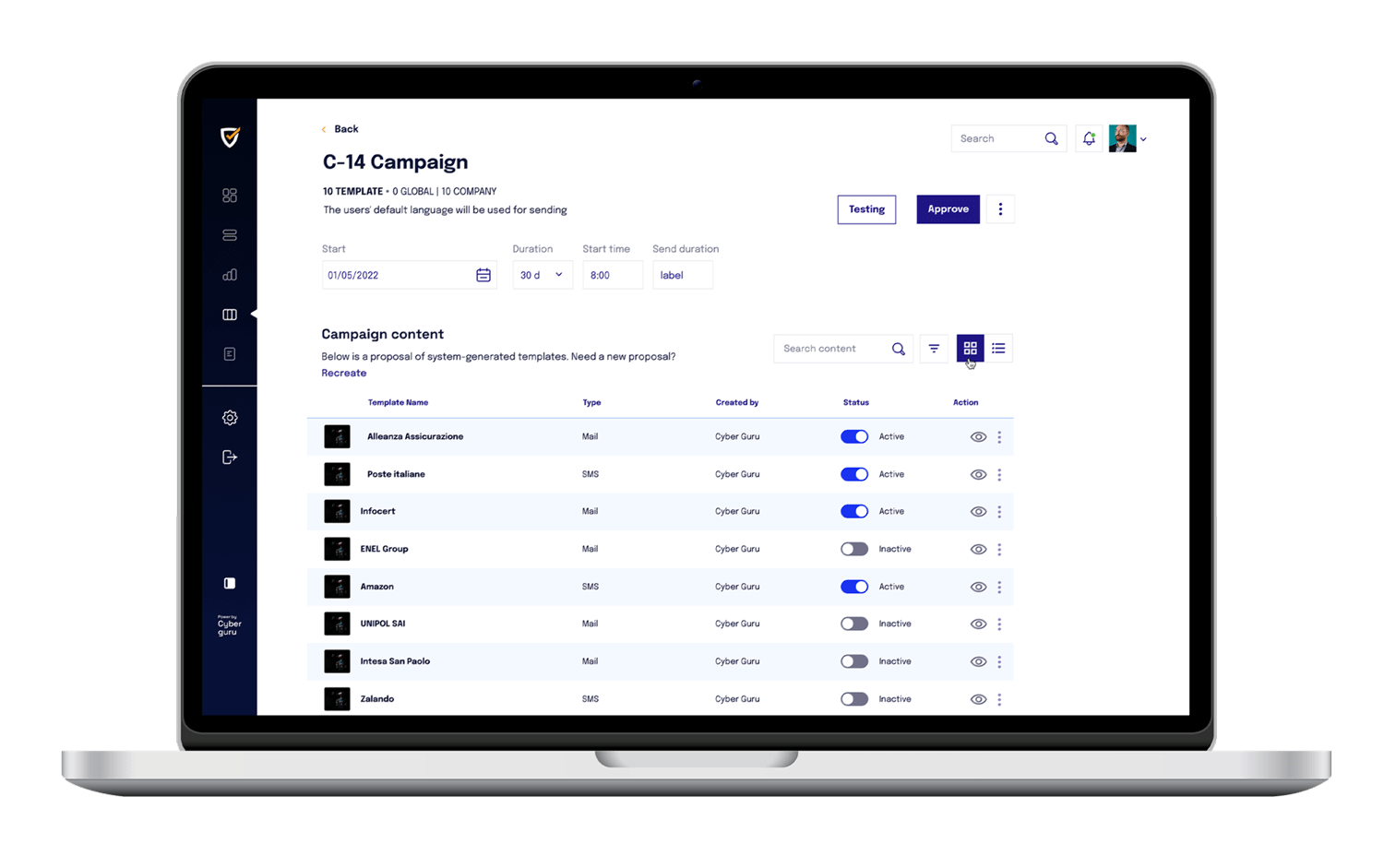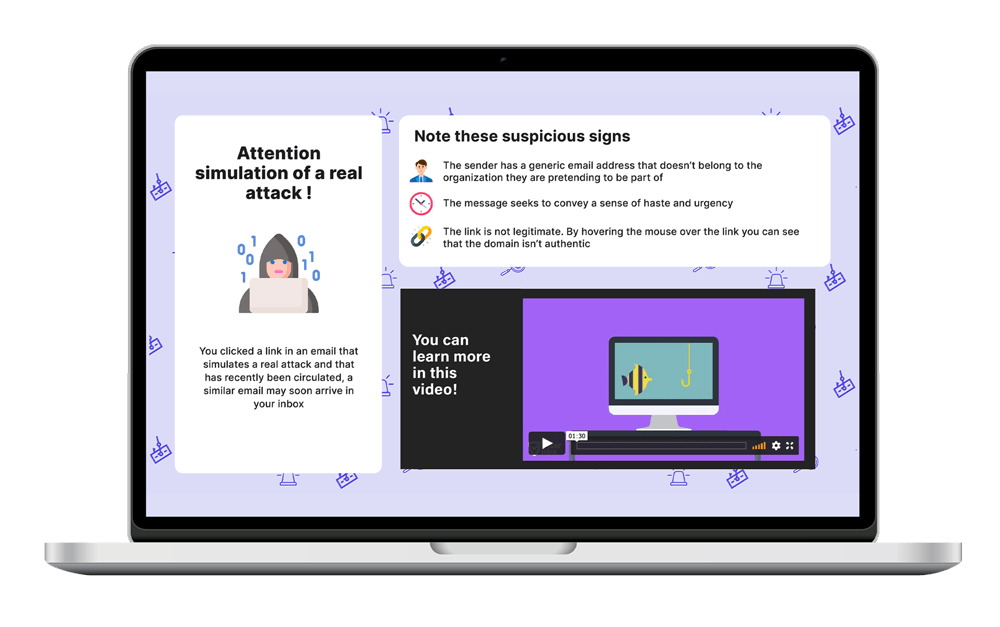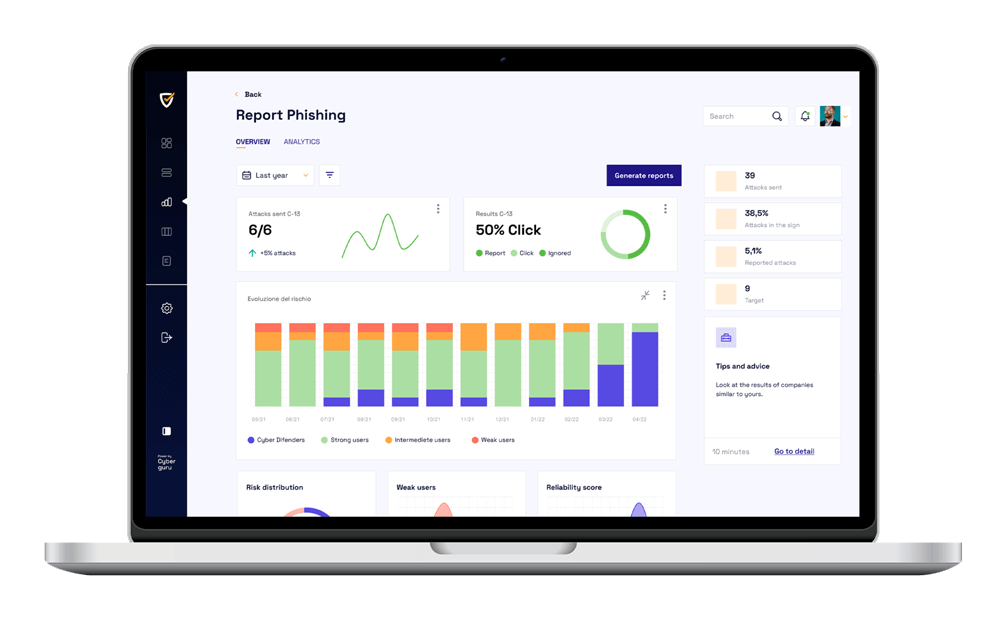Cyber Guru Phishing
Training Platform / Cyber Guru Phishing

Cyber Guru Phishing
Cyber Guru Phishing is the platform’s programme that provides experience-based anti-phishing training. Thanks to the exclusive and innovative Machine Learning model designed specifically for training and education, Cyber Guru Phishing is able to offer a personalised and, above all, adaptive approach, which makes training much more effective and suitable for dealing with new cyberattack techniques.
With its training techniques, special training methodology and experience-based learning, Cyber Guru Phishing maximises training effectiveness in three specific areas: danger perception, readiness to act correctly and threat awareness.
The exclusive Machine Learning model also makes the training programme completely autonomous in the implementation of personalised training programmes and in the programming of simulation campaigns, reducing management costs to zero.
Anti-phishing training with a personal trainer
To protect against the Phishing phenomenon, every organisation must inevitably invest in the human factor, training each user to recognise a Phishing or Smishing attack.
To develop maximum resilience, however, it is necessary to tailor training to the specific characteristics of each individual and their personal ability to resist cyberattacks.
For this reason, Cyber Guru’s Phishing simulation campaigns are personalised, thanks to a personal trainer based on artificial intelligence, based on the behavioural characteristics of each individual user. The user is subjected to simulated attacks with varying frequency, but on a continuous basis, which become increasingly complex and challenging.
To maximise training effectiveness, the adaptive and automatic training paths, decided by the personal trainer on the basis of the results achieved by the individual user, reproduce the real experience by simulating the different attack strategies adopted by cybercriminals.
Simulations carried out
Active customers
Organisations
Features of Cyber Guru Phishing

EXPERIENTIAL TRAINING
- CONTINUOUS TRAINING
- INSTANT ERROR TRAINING
- ADAPTIVE REMEDIATION
- REPORTING PROCEDURE
- MULTILINGUAL FORMAT

PERSONALISED TRAINING
- PERSONALISED SIMULATIONS
- RISK GROUPS
- DIFFICULTY LEVELS
- LOCALISED TEMPLATES
- SIMULATIONS WITH USB AND QR CODES

ZERO-IMPACT
MONITORING
- SaaS PLATFORM
- TURNKEY SERVICE
- AUTOMATED CAMPAIGNS
- PRE-LOADED TEMPLATES
- COMPREHENSIVE REPORTING
Cyber Guru Phishing: adaptive training
Simulations are automatically specialised based on each user’s behavioural profile and their ability to withstand attacks.
Every time the user falls victim to a simulated attack, they are exposed to a light training intervention, which is useful in order to formally understand their mistake and to allow them to process the negative feeling of having made a mistake that they could have avoided.
The adaptive process acts at various levels that condition the automatic selection of attack templates for each campaign and their distribution to the target. This selection is essentially based on some macro variables:
- user profile: based on the specific degree of resistance to attacks, the difficulty level to be used is chosen for each user and the periodicity of the next attack is determined.
- template ranking: the difficulty level of the attack is instead prepared by calculating not only static parameters, but also dynamic ones, such as observing the click-rate that template has amassed in that specific context.

Transform the Phishing experience into effective training
Each campaign will have a different composition from the previous and the next, without the need for any human intervention. The learning algorithms adopted by the platform will be able to select attack templates based on the criterion of maximum training effectiveness.

PHISHING ATTACK
Simulated attacks are structured into campaigns, the result of an adaptive process that automatically determines the selection of ideal attack templates with respect to the development level of the training course.


MICRO TRAINING
If the user fails a simulation, and thus falls for the scam in the template, they immediately receive customised training content on the specificity of the scam in the attack template.


ADVANCED REPORTING
The reporting, available in a dashboard, goes far beyond the simple detection of the average Click-Rate, providing for advanced metrics to assess the risk and track its concrete reduction as the programme progresses.


Want to find out more?

